PMC wraps 2oz of silver around a large copper core for an innovative Hector: The Nine Worthies debut
Just like their 96 Rat lunar coin that we covered earlier this month, Precious Metal Collectors (PMC) have jumped into a genre that is already packed to the rafters with new issues on a regular basis, and just like that coin, they’ve done so with something a bit different. There will be few that would argue the subject of the ancient world isn’t dominated by the Mint of Poland, but producers like Numiscollect and Mint21 have successfully made a niche for themselves with their own unique styles. After all, how boring would the same style over and over be, however excellent is is?
Jumping into the mix with a fascinating look at The Nine Worthies, a group of ancient, biblical and medieval figures said to embody the concept of chivalry, PMC have embraced a bold artistic style, and done so on a quite unusual coin format. The coin is struck to an impressive level of relief using two ounces of fine silver, but that silver is wrapped around a core of copper weighing in at 11.5 ounces. The end result is a chunky 80.0 mm diameter coin with ultra high relief over both faces, all struck in silver, but not bearing the cost that would be imposed if it were the precious metal all the way through.
It’s a pretty, classically styled work depicting the first of the Nine Worthies, Hector, the Trojan warrior that was slain by Achilles. There’s tons of detail packed into each face of the coin, with both sides enjoying very high levels of relief. The Niue issue details are kept neatly bound in their own space on the obverse. It bodes well for the series as a whole, and it’s an artistic style that would lend itself well to the medieval subjects of the third triad. We look forward to seeing what PMC do with those.
As with the 96 Rat coin, the presentation looks to be outstanding, with a good looking themed box. The solid silver 3.1 gram Certificate of Authenticity is back again. This is especially cool in that it is actually a coin in itself, carrying a denomination of 25 cents. You can see the one from the Rat 96 issue further down, as we’ve yet to get an image of the one for Hector (although it remains almost identical). The certs are ‘issued’ for the Order of the Spectres, a group of designers, and will carry on the numbering sequence from the 96 Rat issue – so the first of these will be numbered 97. Depicting Nikola Tesla, it will remain a constant tie through the various issues. A fine first issue in a series with a very interesting theme.
THE NINE WORTHIES
The Nine Worthies are nine historical, scriptural, and legendary personages who personify the ideals of chivalry established in the Middle Ages, whose lives were deemed a valuable study for aspirants to chivalric status. All were commonly referred to as ‘Princes’, regardless of their historical titles. They were first described in the early fourteenth century, by Jacques de Longuyon in his Voeux du Paon.
The Nine Worthies include three pagans, three Jews and three Christians. As a group, the nine worthies represent all facets of the perfect chivalrous warrior. All, with the exception of Hector, are conquering heroes. Those not royal were presumed to come from knightly families. All lived in the pre-heraldic era, and attributed arms were invented for them, as in Lucas van Leyden’s engraving. All brought glory and honour to their nations and were noted for their personal prowess in arms. As individuals, each displayed some outstanding quality of chivalry which made them exemplars of knighthood. That the nine individual figures were generally not distinguished, iconographically, with respect to relative antiquity or ethnicity, would suggest that the virtues that they manifest are to be understood as timeless and universal.
PAGANS
HECTOR: In Greek mythology and Roman mythology, Hector was a Trojan prince and the greatest fighter for Troy in the Trojan War. He acted as leader of the Trojans and their allies in the defence of Troy, “killing 31,000 Greek fighters”, offers Hyginus.
ALEXANDER THE GREAT: Alexander III of Macedon (20/21 July 356 BC – 10/11 June 323 BC), was a king (basileus) of the ancient Greek kingdom of Macedon and a member of the Argead dynasty. He succeeded his father Philip II to the throne at the age of 20. He spent most of his ruling years on an unprecedented military campaign through Asia and north-east Africa, and by the age of thirty, he had created one of the largest empires of the ancient world, stretching from Greece to northwestern India. He was undefeated in battle and is widely considered one of history’s most successful military commanders.
GAIUS JULIUS CAESAR: (12 or 13 July 100 BC – 15 March 44 BC), known by his nomen and cognomen Julius Caesar, was a populist Roman dictator, politician, and military general who played a critical role in the events that led to the demise of the Roman Republic and the rise of the Roman Empire. He was also a historian and wrote Latin prose. Caesar is considered by many historians to be one of the greatest military commanders in history.
JEWS
JOSHUA: Is the central figure in the Hebrew Bible’s Book of Joshua. According to the books of Exodus, Numbers and Joshua, he was Moses’ assistant and became the leader of the Israelite tribes after the death of Moses. His name was Hoshea the son of Nun, of the tribe of Ephraim, but Moses called him Joshua (Numbers 13:16), the name by which he is commonly known. According to the Bible he was born in Egypt prior to the Exodus.
DAVID: Is described in the Hebrew Bible as the third king of the United Monarchy of Israel and Judah, after Ish-bosheth. In the biblical narrative, David is a young shepherd who gains fame first as a musician and later by killing the enemy champion Goliath. He becomes a favourite of King Saul. Worried that David is trying to take his throne, Saul turns on David. After Saul and his son Jonathan are killed in battle, David is anointed as King. David conquers Jerusalem, taking the Ark of the Covenant into the city, and establishing the kingdom founded by Saul. Before his peaceful death, he chooses his son Solomon as successor. He is honoured in the prophetic literature as an ideal king and the forefather of a future Messiah, and many psalms are ascribed to him.
JUDAS MACCABEUS: Was the third son of Mattathias the Hasmonean, a Jewish priest from the village of Modiin. In 167 BCE Mattathias, together with his sons Judah, Eleazar, Simon, John, and Jonathan, started a revolt against the Seleucid ruler Antiochus IV Epiphanes, who since 175 BCE had issued decrees that forbade Jewish religious practices. After Mattathias’s death in 166 BCE, Judah assumed leadership of the revolt in accordance with the deathbed disposition of his father. The First Book of Maccabees praises Judah’s valour and military talent, suggesting that those qualities made Judah a natural choice for the new commander.
CHRISTIANS
KING ARTHUR: also called Arthur Pendragon, was a legendary British leader who, according to medieval histories and romances, led the defence of Britain against Saxon invaders in the late 5th and early 6th centuries. The details of Arthur’s story are mainly composed of folklore and literary invention, and modern historians generally agree that he is unhistorical. The sparse historical background of Arthur is gleaned from various sources, including the Annales Cambriae, the Historia Brittonum, and the writings of Gildas. Arthur’s name also occurs in early poetic sources such as Y Gododdin.
CHARLEMAGNE: or Charles the Great (2 April 748 – 28 January 814), numbered Charles I, was king of the Franks from 768, king of the Lombards from 774, and emperor of the Romans from 800. During the Early Middle Ages, he united the majority of western and central Europe. He was the first recognised emperor to rule from western Europe since the fall of the Western Roman Empire three centuries earlier. The expanded Frankish state that Charlemagne founded is called the Carolingian Empire. He was later canonized by Antipope Paschal III.
GODFREY OF BOUILLON: (18 September 1060 – 18 July 1100) was one of the leaders of the First Crusade from 1096 until its conclusion in 1099. He was the lord of Bouillon, from which he took his byname, from 1076 and the duke of Lower Lorraine from 1087. After the successful siege of Jerusalem in 1099, Godfrey became the first ruler of the Kingdom of Jerusalem. He refused the title of king, however, as he believed that the true king of Jerusalem was Jesus Christ, preferring the title of advocate (i.e., protector or defender) of the Holy Sepulchre. He is also known as the “baron of the Holy Sepulchre” and the “crusader king”.
| SPECIFICATION | |
| DENOMINATION | $5 NZD (Niue) |
| COMPOSITION | 0.999 silver / Copper |
| WEIGHT | 62.2 grams (Ag) / 357.7 grams (Cu) |
| DIMENSIONS | 80.0 mm |
| FINISH | Antique |
| MODIFICATIONS | Ultra high relief |
| MINTAGE | 500 |
| BOX / C.O.A. | Yes / Yes (Made of 3.1g silver) |


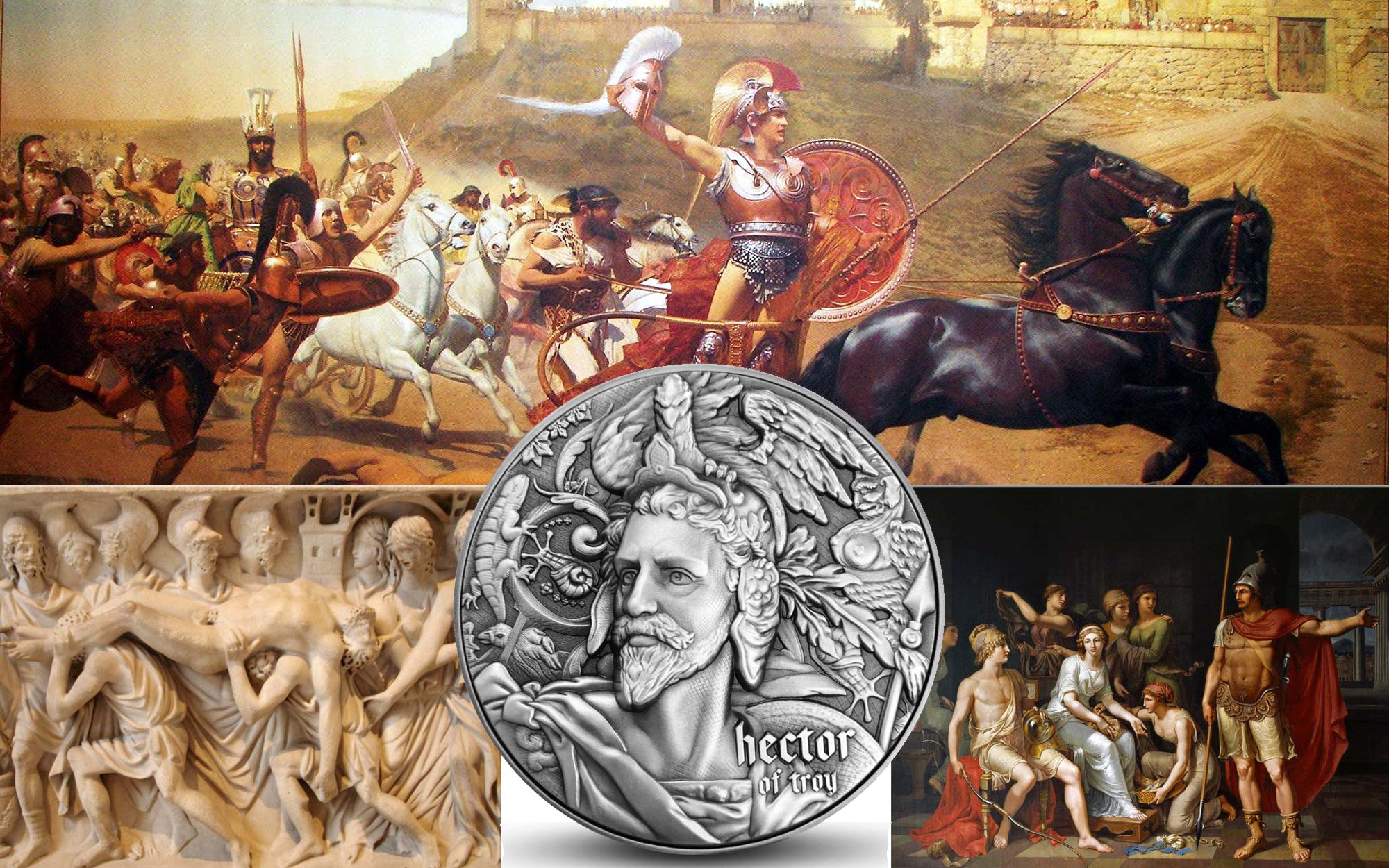
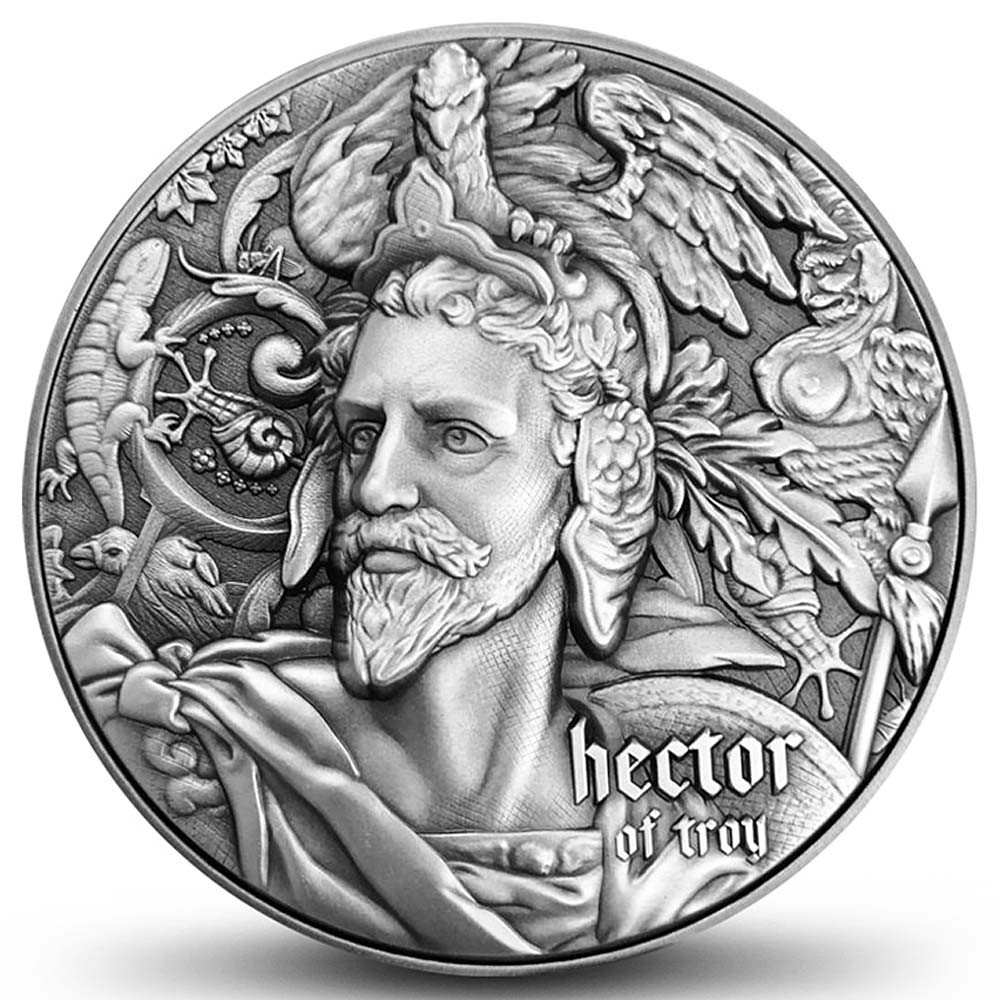
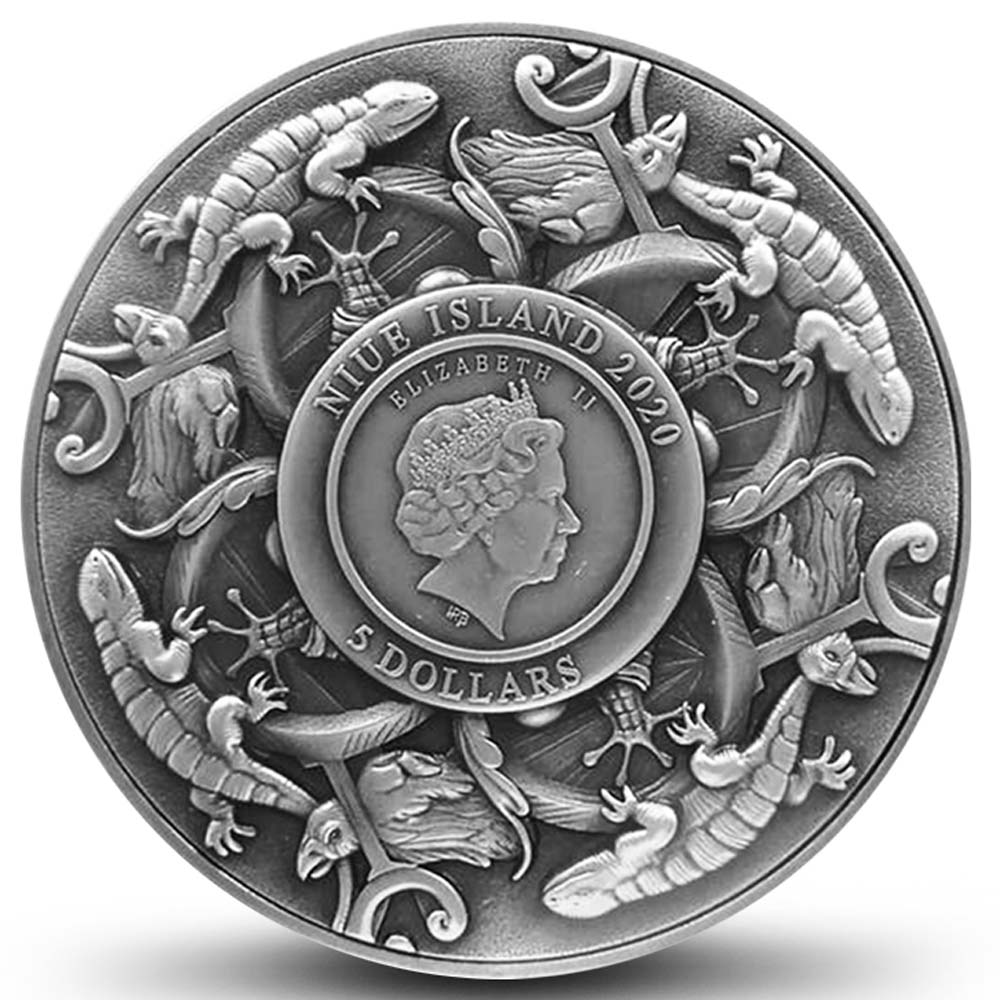
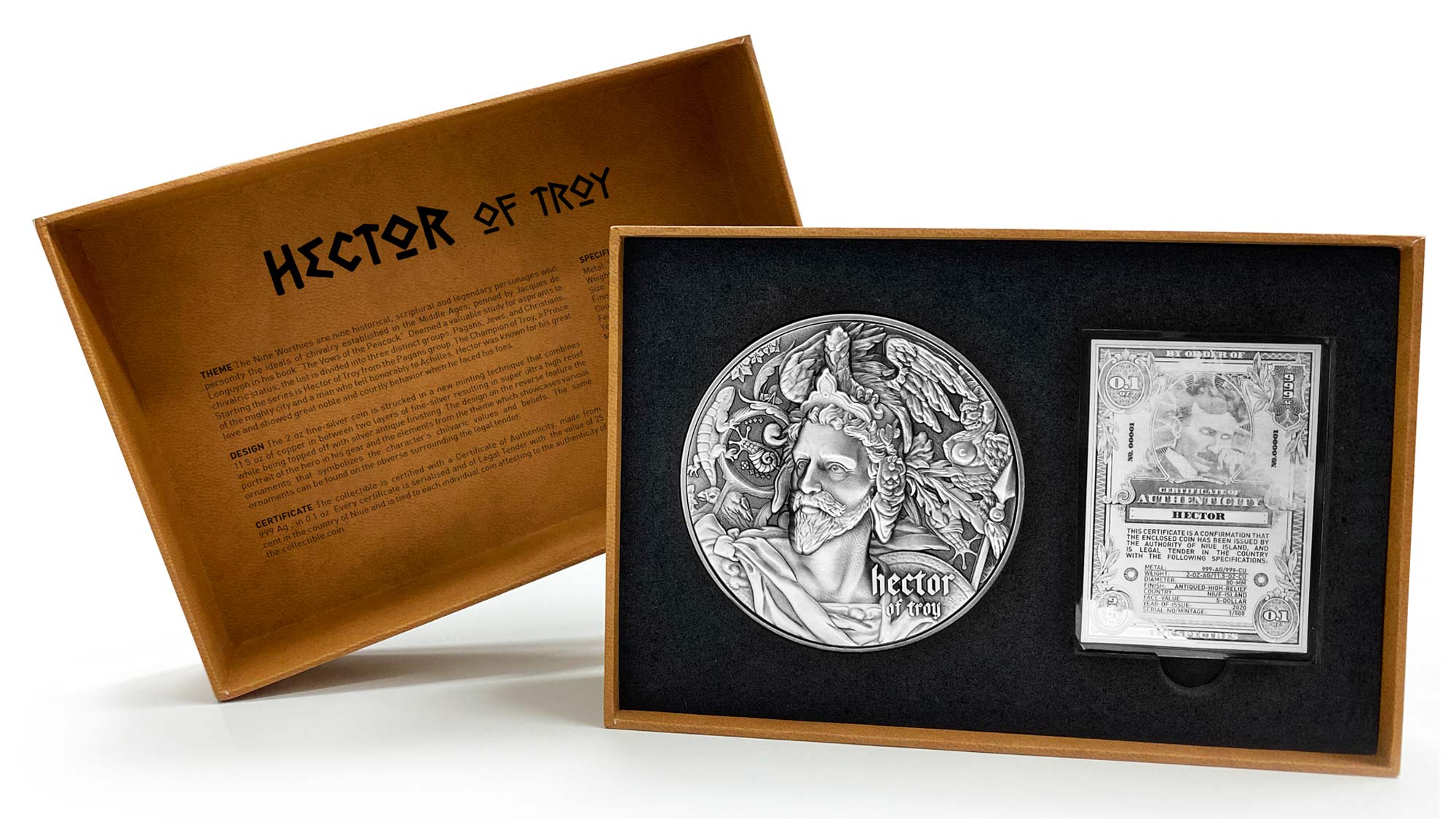

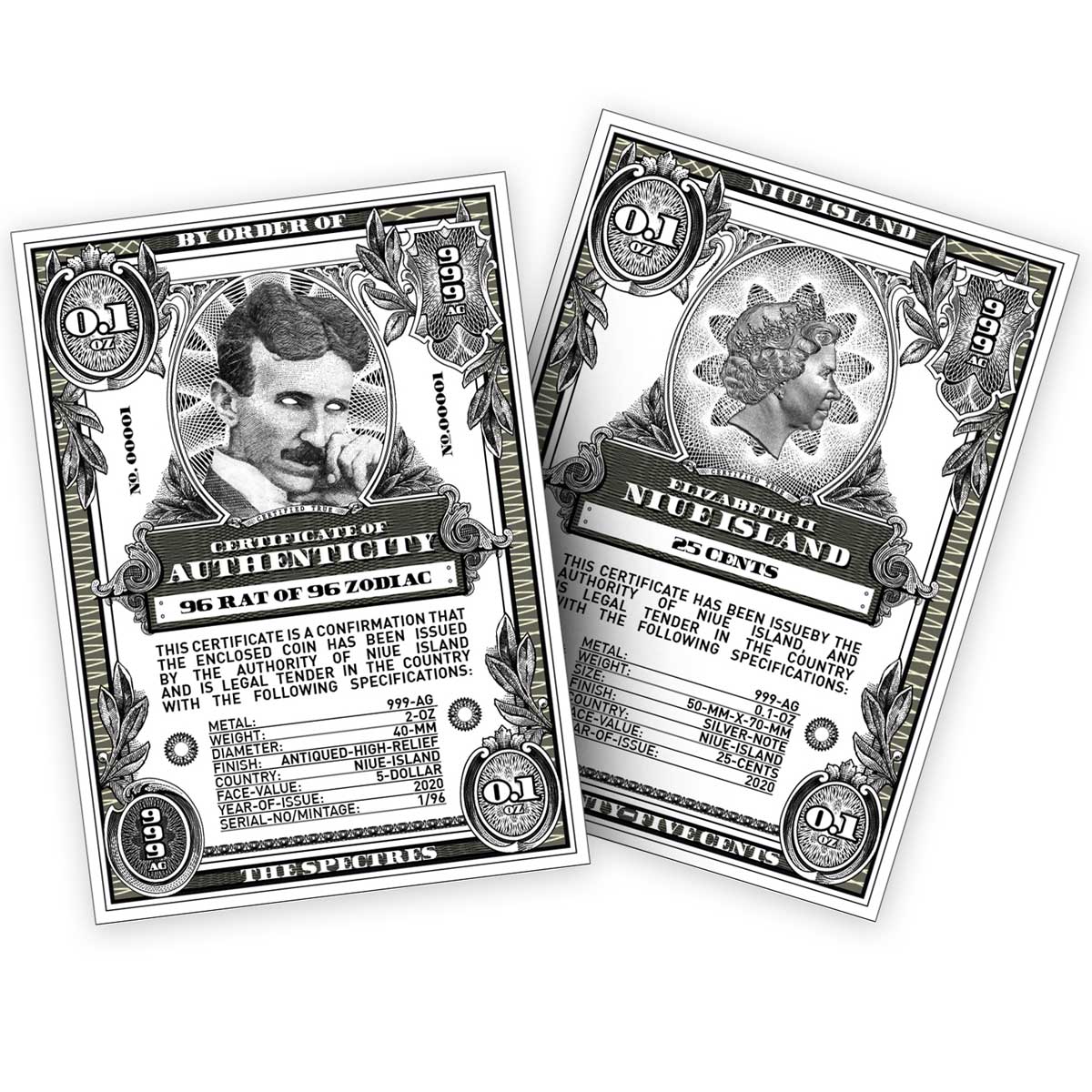
When I was buying it I had a big expectations from this coin as it is unique by many aspects. However, when I actually could see it in live I was absolutely stunned, it definitely overreached my expectations and in real it looks far better. Also it has certificate made of silver included, very original, never seen anything alike….. I am looking forward to see future coins in this series….
I own this Hector coin along with the Vlad the Impaler issue. PMC’s themes are very interesting ones, quite unique as is their use of the bi-metal wrapping.
The packaging that comes with these coins is first rate, especially the silver certificates with these 2 coins.
These are hefty pieces, so much so I decided to weigh each one. I was a bit surprised to find that there was quite a difference between the two.
The Vlad coin weighed in at 416.8 grams and the Hector coin was 394.4 grams.
Both are still more than their declared weight of 388.23 total grams of both silver & copper combined.
I am assuming that the extra weight is probably in the copper core. However, I’m a bit surprised that there is that much difference (22.4 grams) between the 2 coins.
Again I’m concluding that their declared total metal weight would be 388.23 total grams.
Since copper ( a non precious metal ) is bought and sold using the “AVDP” weighting and not “troy” weighting, the 11.5 oz copper core would be 326.03 grams and then add the 2oz silver “troy” weight of 62.2 grams and that then totals 388.23.
Mik……..If I used the specs you list above, then both of my coins would be less than the mint’s declared metal weight.
I’m sure my weights on my 2 PMC coins is pretty accurate as I use a Torbal AD series scale.
Anyway, just some food for thought.